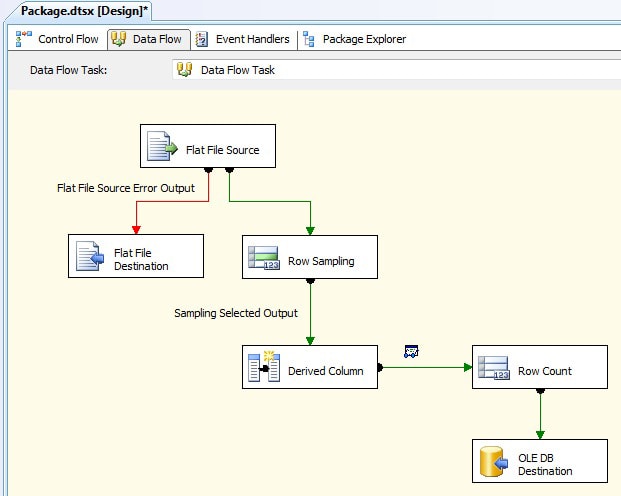Visual Studio 2008 overview.pptx. Date Published: 5/14/2008. File Size: 6.2 MB. Visual Studio 2008. System Requirements. Supported Operating System. Windows Server 2003, Windows Server 2003 Itanium-based editions, Windows Server 2003 R2 (32-Bit x86), Windows Server 2003 R2 Datacenter Edition (32-Bit x86), Windows Server 2003 R2 Datacenter x64. City scoped at the Data Flow Task level will serve as the comparison criteria in the Conditional Split Transformation. Package-wide dstFilePath will contain the file name and path of the Flat File Destination. Each of them will be part of the default User namespace (although it is certainly possible to define a custom namespace for this purpose).
 -->
-->SQL Server 2005 and 2008 use the legacy Package Deployment Model. This model is based on the package, which is the unit of deployment. However, SSIS packages usually interact with others and it is necessary to pass connection and parameters from one package to another.

Applies to: SQL Server (all supported versions) SSIS Integration Runtime in Azure Data Factory
In this task, you modify the Flat File connection manager from Lesson 1. That Flat File connection manager is configured to statically load a single file. To enable the Flat File connection manager to iteratively load files, you change the ConnectionString property of the connection manager to use the user-defined variable User::varFileName, which contains the path of the file to be loaded at run time.
By modifying the connection manager to use the value of the user-defined variable to change the ConnectionString property, the connection manager connects to different flat files. At run time, each iteration of the Foreach Loop container updates the User::varFileName variable. Updating the variable, in turn, causes the connection manager to connect to a different flat file, and the data flow task to process a different set of data.
Configure the Flat File connection manager to use a variable

In the Connection Managers pane, right-click Sample Flat File Source Data, and select Properties.
In the Properties window make sure the PackagePath starts with Package.Connections. If not, in the Connection Managers pane, right-click Sample Flat File Source Data, and select Convert to Package Connection
In the Properties window, for Expressions, select the empty cell, and then select the ellipsis button (...).
In the Property Expressions Editor dialog, in the Property column, select ConnectionString.
In the Expression column, select the ellipsis button (...) to open the Expression Builder dialog box.
In the Expression Builder dialog, expand the Variables node.
Drag the variable User::varFileName into the Expression box.
Select OK to close the Expression Builder dialog.
Select OK again to close the Property Expressions Editor dialog.
Go to next task
-->Applies to: SQL Server (all supported versions) SSIS Integration Runtime in Azure Data Factory
The error output of the Lookup Currency Key transformation redirects any data rows that failed the lookup to the Script transformation operation. To provide more information about the errors that occurred, the Script transformation runs a script that gets each error's description.

In this task, you save all this information about the failed rows to a delimited text file for later processing. To save the failed rows, you add and configure a Flat File connection manager for the text file that contains the error data and a Flat File destination. By setting properties on the Flat File connection manager that the Flat File destination uses, you can specify how the Flat File destination formats and writes the text file. For more information, see Flat File connection manager and Flat File destination.
Add and configure a Flat File destination
Select the Data Flow tab.
In the SSIS Toolbox, expand Other Destinations, and drag Flat File Destination onto the data flow design surface. Put the Flat File Destination directly underneath the Get Error Description transformation.
Select the Get Error Description transformation, and then drag the blue arrow onto the new Flat File Destination.
On the Data Flow design surface, select the name Flat File Destination in the new Flat File Destination transformation, and change that name to Failed Rows.
Right-click the Failed Rows transformation, select Edit, and then in the Flat File Destination Editor, select New.
In the Flat File Format dialog box, verify that Delimited is selected, and then select OK.
In the Flat File Connection Manager Editor, in the Connection Manager Name box enter Error Data.
In the Flat File Connection Manager Editor dialog box, select Browse, and locate the folder in which to store the file.
In the Open dialog box, for File name, enter ErrorOutput.txt, and then select Open.
In the Flat File Connection Manager Editor dialog box, verify that Locale is English (United States) and Code page is 1252 (ANSI-Latin I).
In the options pane, select Columns.
In addition to the columns from the source data file, there are three new columns: ErrorCode, ErrorColumn, and ErrorDescription. These columns are the error output of the Lookup Currency Key transformation and the script in the Get Error Description transformation. You can use these columns to troubleshoot the cause of the failed row.
Select OK.
In the Flat File Destination Editor, clear the Overwrite data in the file check box.
Clearing this check box persists the errors over multiple package executions by appending each new run's error output.
In the Flat File Destination Editor, select Mappings to verify that all the columns are correct. Optionally, you can rename the columns in the destination.
Select OK.